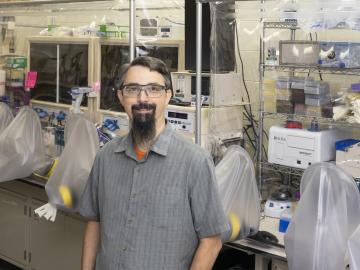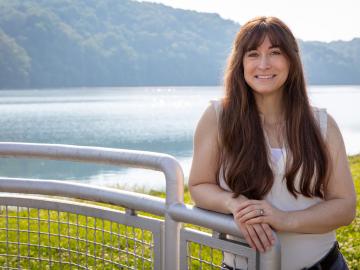
Filter News
Area of Research
- (-) Biology and Environment (47)
- (-) Building Technologies (4)
- (-) Neutron Science (24)
- Advanced Manufacturing (8)
- Biological Systems (1)
- Computational Biology (2)
- Computational Engineering (2)
- Computer Science (8)
- Electricity and Smart Grid (1)
- Energy Science (114)
- Energy Sciences (1)
- Fuel Cycle Science and Technology (1)
- Functional Materials for Energy (1)
- Fusion and Fission (32)
- Fusion Energy (11)
- Isotope Development and Production (1)
- Isotopes (10)
- Materials (44)
- Materials for Computing (6)
- National Security (24)
- Nuclear Science and Technology (39)
- Nuclear Systems Modeling, Simulation and Validation (1)
- Quantum information Science (1)
- Sensors and Controls (1)
- Supercomputing (62)
News Topics
- (-) Artificial Intelligence (14)
- (-) Biomedical (29)
- (-) Buildings (5)
- (-) Nuclear Energy (4)
- (-) Security (4)
- 3-D Printing/Advanced Manufacturing (16)
- Advanced Reactors (2)
- Big Data (11)
- Bioenergy (52)
- Biology (78)
- Biotechnology (14)
- Chemical Sciences (15)
- Clean Water (13)
- Composites (5)
- Computer Science (32)
- Coronavirus (20)
- Critical Materials (1)
- Cybersecurity (1)
- Energy Storage (13)
- Environment (99)
- Exascale Computing (4)
- Fossil Energy (1)
- Frontier (4)
- Fusion (1)
- Grid (3)
- High-Performance Computing (22)
- Hydropower (9)
- Isotopes (2)
- Machine Learning (11)
- Materials (25)
- Materials Science (28)
- Mathematics (4)
- Mercury (7)
- Microscopy (13)
- Molten Salt (1)
- Nanotechnology (17)
- National Security (5)
- Neutron Science (120)
- Partnerships (6)
- Physics (11)
- Polymers (3)
- Quantum Computing (1)
- Quantum Science (7)
- Simulation (15)
- Space Exploration (3)
- Summit (15)
- Transportation (8)
Media Contacts

As a metabolic engineer at Oak Ridge National Laboratory, Adam Guss modifies microbes to perform the diverse processes needed to make sustainable biofuels and bioproducts.

Scientists at ORNL and the University of Wisconsin–Madison have discovered that genetically distinct populations within the same species of fungi can produce unique mixes of secondary metabolites, which are organic compounds with applications in

Oak Ridge National Laboratory researchers designed and field-tested an algorithm that could help homeowners maintain comfortable temperatures year-round while minimizing utility costs.

An ORNL-led team comprising researchers from multiple DOE national laboratories is using artificial intelligence and computational screening techniques – in combination with experimental validation – to identify and design five promising drug therapy approaches to target the SARS-CoV-2 virus.

Carly Hansen, a water resources engineer at Oak Ridge National Laboratory, is rethinking what’s possible for hydropower in the United States.

At the Department of Energy’s Oak Ridge National Laboratory, scientists use artificial intelligence, or AI, to accelerate the discovery and development of materials for energy and information technologies.

Belinda Akpa is a chemical engineer with a talent for tackling big challenges and fostering inclusivity and diversity in the next generation of scientists.

Rich Giannone uses bioanalytical mass spectrometry to examine proteins, the primary driver in biological systems.

The Accelerating Therapeutics for Opportunities in Medicine , or ATOM, consortium today announced the U.S. Department of Energy’s Oak Ridge, Argonne and Brookhaven national laboratories are joining the consortium to further develop ATOM’s artificial intelligence, or AI-driven, drug discovery platform.

Scientists have found new, unexpected behaviors when SARS-CoV-2 – the virus that causes COVID-19 – encounters drugs known as inhibitors, which bind to certain components of the virus and block its ability to reproduce.


